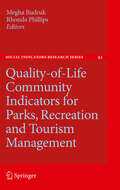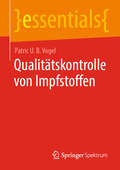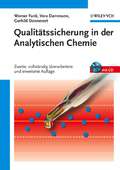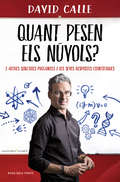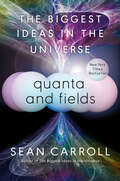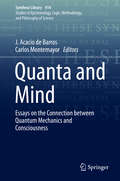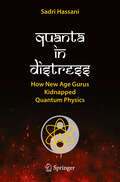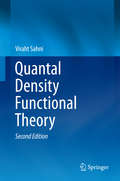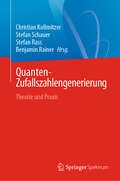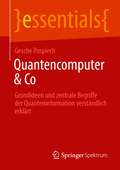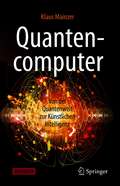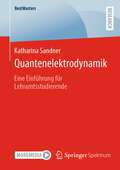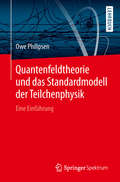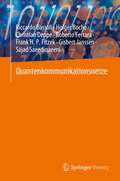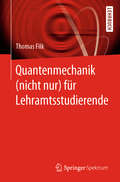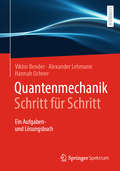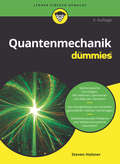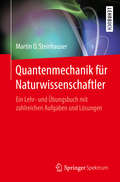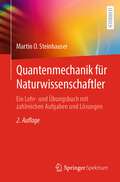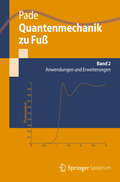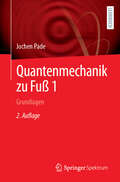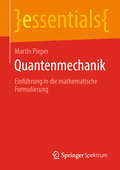- Table View
- List View
Quality-of-Life Community Indicators for Parks, Recreation and Tourism Management
by Rhonda Phillips Megha BudrukWhile community quality-of-life indicators are gaining much needed attention in both scholarly work and practice, their application in the areas of parks, recreation and tourism management are not as well known. The applicability of indicator systems for natural resource and natural resource area management within the parks and recreation arena is very high, including urban parks and recreation programs and their influence on quality of life. Tourism is also an area that needs much more work in terms of assessing impacts as well as developing indicators for gauging progress in the long term. All three areas are an integrated discipline and most programs throughout the developed world are housed co-jointly. There are several researchers across the globe who are conducting innovative work in these areas. The editors feel that a volume on the topic will spur additional interests as well as serve to lead the research efforts.
Qualitätskontrolle in der TCM: Chinesische Heilpflanzen auf dem Prüfstand
by Oliver Johannes Schmitz Alexandra-Friederike von TrothaDie Traditionelle Chinesische Medizin (TCM) und die Verwendung chinesischer Arzneidrogen und ihre Zubereitungen erfreuen sich hierzulande als Alternative zur Schulmedizin immer größerer Beliebtheit Um die Sicherheit, Wirksamkeit und konstant hochwertige Qualität der Arzneien für Patienten zu gewährleisten ist eine Qualitätskontrolle unerlässlich. Das Buch führt im Grundlagenteil in die Geschichte und Philosophie der TCM ein, zeigt die wirtschaftliche Bedeutung von Heilpflanzen, erklärt die Wirkung der Vorbehandlungsmethoden (Paozhi-Verfahren) und vor allem die Gefahren der unreflektierten Einnahme. Der größere Teil widmet sich den Gründen und Methoden einer vernünftigen Qualitätskontrolle von chinesischen Heilpflanzen. Unter anderem werden wichtige Themen wie Toxizität, mögliche Belastungen mit Pestiziden, Schwermetallen oder Mykotoxine diskutiert. Nur weil ein Produkt natürlichen Ursprungs ist, darf kein Rückschluss auf kein Gefährdungspotenzial geschlossen werden. Das Buch richtet sich an naturheilkundlich tätige Ärzte, Pharmazeuten, Apotheker und an Heilpflanzen interessierte Personen.
Qualitätskontrolle von Impfstoffen (essentials)
by Patric U. VogelIn diesem Buch wird die Qualitätskontrolle von Impfstoffen dargestellt. Hierzu zählen neben der Durchführung von analytischen Prüfungen verschiedenste qualitätsrelevante Aufgaben, z.B. die Festlegung von Qualitätsanforderungen, die Analyse von unerwarteten Ergebnissen oder Stabilitätsuntersuchungen, die die Qualitätskontroll-Einheit erfüllen muss. Die Abläufe sind hochreguliert und dienen der Patientensicherheit. Es gibt aber auch Beispiele, bei denen trotz erfolgreicher Qualitätskontrolle Qualitätsmängel möglich sind, die Schaden verursachen können.
Qualitätssicherung in der Analytischen Chemie: Anwendungen in der Umwelt-, Lebensmittel9;- und Werkstoffanalytik, Biotechnologie und Medizintechnik
by Gerhild Donnevert Werner Funk Vera DammannEin Nachweis der Verlasslichkeit analytischer Daten ist nur mit entsprechenden Qualitatssicherungsma?nahmen moglich. Dies gilt fur die Umwelt- oder Lebensmitteluberwachung, die Werkstoffanalytik, aber auch die Bioanalytik in der biotechnologischen Industrie oder im medizinischen Bereich (In-vitro-Diagnostik, Point-of-Care-Testing). Die Autoren stellen dafur ein bewahrtes, durchgangiges Konzept vor, das auf statistischen Methoden beruht und von der Entwicklung einer analytischen Methode bis zu ihrer routinema?igen Anwendung reicht. Die zweite, komplett uberarbeitete Auflage enthalt neue Kapitel, unter anderem zu dem aktuellen Thema "Me?unsicherheit" und wird durch eine CD mit praktischen Rechenbeispielen abgerundet. Bezuglich der einschlagigen Normung reprasentiert das Buch den neuesten Stand. Rezensenten urteilen uber dieses Buch: Laborleiter oder Behordenvertreter finden eine verla?liche Anleitung und Nachschlagequelle. Daruber hinaus ist das Buch ein Lehr- und Ubungsbuch fur alle im Labor Tatigen. (Chemische Rundschau) Als Autoren konnten ausgewiesene Fachleute dieses Gebietes gewonnen werden. Das inzwischen fur jedes analytische Labor unverzichtbare Konzept der Qualitatssicherung wird anhand von 4 Phasen behandelt ... Didaktisch besonders geschickt sind die zahlreichen "durchgerechneten" Beispiele mit Zwischenergebnissen, Tabellen und Checklisten. Es handelt sich um eine unentbehrliche Informationsquelle, die gerade unter dem Gesichtspunkt der "guten Laborpraxis" (GLP) in jede analytische Bibliothek gehort. (Klinisches Labor) Das Buch ist ubersichtlich angelegt und stellt fur den Analytiker eine verla?liche Anleitung und Nachschlagequelle zur Qualitatssicherung dar. Daruber hinaus eignet es sich fur alle im analytischen Labor Tatigen als ein Lehr- und Ubungsbuch. (Die Nahrung -- Food) Jeder Analytiker mu? sich mit den Methoden der Qualitatssicherung beschaftigen. Das vorliegende Lehr- und Ubungsbuch kann ihm dabei eine wertvolle Hilfe sein. (Archiv fur Kriminologie)
Quant pesen els núvols?: I altres senzilles preguntes i les seves respostes científiques
by David CalleDescobreix l'univers del professor estrella de YouTube que ha ajudat milers d'alumnes a perseguir els seus somnis. Finalista del Global Teacher Price i una de les persones més creatives del món, segons Forbes. Per què el veí de sota viurà més anys que tu?De quin color és un mirall? Quant pesa el martell de Thor?Per què no podem viatjar al passat?Quants megapíxels té l'ull humà? ------- - Llegir aquest llibre t'ocuparà el 0,0005% de la vida, entre uns 7.200 i uns 14.400 segons. Potser els mateixos que veure Blade Runner 2049 o la trilogia original de Star Wars. Tot i que ja saps que el temps és relatiu, com tantes altres coses. - Si gaudeixes d'una vida llarga i pròspera, viuràs més de dos mil milions de segons, malgrat que la tercera part d'aquest temps la passaràs dormint. La resta et tocarà estar despert, viure i gaudir, perquè pot ser apassionant. Així que rumia bé en què vols invertir aquests segons. - D'aquí a uns quants anys, algunes de les afirmacions que llegiràs en aquest llibre, avui dia considerades del tot certes, pot ser que ja no tinguin sentit. Res no és permanent, res no és constant. «L'únic constant és el canvi», va predir Heràclit ara fa 2.500 anys. És el meravellós de la ciència: que avança imparable dia rere dia. Per això vull que aquest llibre et serveixi d'inspiració i t'ajudi a construir els teus somnis, a iniciar la pròpia recerca de respostes a totes les preguntes que et passin pel cap sense haver d'apel·lar als déus de l'Olimp, que sempre aporten una resposta o altra, mitològica i fascinant, però no gens científica. ------ A quina temperatura bull l'aigua al cim de l'Everest? Quina llei física transgredeixen les naus de Star Wars? Com podríem escapar-nos de la Terra? Ens dominaran els robots? Per què el cel és blau? Per què no podem viatjar al passat? Per què l'univers i la teva habitació tendeixen sempre al màxim desordre? Serem cíborgs en un futur? Quina alçària màxima pot assolir un castell de sorra? Quants diners costaria endur-se una pilota de futbol a l'espai? Quantes pomes va esmicolar Galileu per experimentar amb la gravetat? Quantes aranyes calen per frenar un Boeing 747? Què passaria si s'invertissin els pols de la Terra? Per què s'escalfa la Terra? Com seran els mapes del futur?
Quanta and Fields: The Biggest Ideas in the Universe
by Sean CarrollThe instant New York Times bestsellerQuanta and Fields, the second book of Sean Carroll&’s already internationally acclaimed series The Biggest Ideas in the Universe, is an adventure into the bare stuff of reality. Sean Carroll is creating a profoundly new approach to sharing physics with a broad audience, one that goes beyond analogies to show how physicists really think. He cuts to the bare mathematical essence of our most profound theories, explaining every step in a uniquely accessible way. Quantum field theory is how modern physics describes nature at its most profound level. Starting with the basics of quantum mechanics itself, Sean Carroll explains measurement and entanglement before explaining how the world is really made of fields. You will finally understand why matter is solid, why there is antimatter, where the sizes of atoms come from, and why the predictions of quantum field theory are so spectacularly successful. Fundamental ideas like spin, symmetry, Feynman diagrams, and the Higgs mechanism are explained for real, not just through amusing stories. Beyond Newton, beyond Einstein, and all the intuitive notions that have guided homo sapiens for millennia, this book is a journey to a once unimaginable truth about what our universe is.
Quanta and Mind: Essays on the Connection between Quantum Mechanics and the Consciousness (Synthese Library #414)
by Carlos Montemayor J. Acacio de BarrosThis edited volume examines aspects of the mind/consciousness that are relevant to the interpretations of quantum mechanics. In it, an international group of contributors focus on the possible connections between quantum mechanics and consciousness. They look at how consciousness can help us with quantum mechanics as well as how quantum mechanics can contribute to our understanding of consciousness. For example, what do different interpretations aimed at solving the measurement problem in quantum mechanics tell us about the nature of consciousness, such as von Neumann's interpretation? Each interpretation has, associated to it, a corresponding metaphysical framework that helps us think about possible “models” of consciousness. Alternatively, what does the nature of consciousness tell us about the role of the observer and time reversibility in the measurement process? The book features 20 papers on contemporary approaches to quanta and mind. It brings together the work of scholars from different disciplines with diverse views on the connections between quanta and mind, ranging from those who are supportive of a link between consciousness and quantum physics to those who are very skeptical of such link. Coverage includes such topics as free will in a quantum world, contextuality and causality, mind and matter interaction, quantum panpsychism, the quantum and quantum-like brain, and the role of time in brain-mind dynamics.
Quanta in Distress: How New Age Gurus Kidnapped Quantum Physics
by Sadri HassaniThis book deconstructs and debunks the lucrative and widespread marriage of quantum physics with pop-spirituality while tracing this pernicious strain of pseudoscience to its source: the founders of quantum mechanics themselves. The association of mystical ideas with modern physics in the self-improvement industry is not new. The “spookiness” of quantum properties like uncertainty and entanglement has proven fertile ground for new-age mystics and alternative medicine advocates who saw a way to put a scientific veneer on their claims. In the early days, the founders of quantum physics accused it of implying an observer-created reality. Later, Taoists and Wu Li dancers were quantized. Then ancient Indian medicine, Ayurveda, morphed into “quantum healing.” Little wonder The Oprah Winfrey Show told its viewers: think about losing weight, making more money, and falling in love, and you’ll become thin, wealthy, and happily married … all based on quantum physics. Criticism of the pseudoscientific misappropriation of quantum physics has been widespread but inadequate; thus far, the scientific community has failed to account for its own role in the fusion of pop-spirituality and quantum physics. As well as thoroughly exploring and debunking quantum mysticism, this book traces the development of quantum mysticism and pulls no punches in exposing the unwitting role of quantum theory’s founders in propagating quantum mysticism.
Quantal Density Functional Theory
by Viraht SahniThis book deals with quantal density functional theory (QDFT) which is a time-dependent local effective potential theory of the electronic structure of matter. The treated time-independent QDFT constitutes a special case. In the 2nd edition, the theory is extended to include the presence of external magnetostatic fields. The theory is a description of matter based on the 'quantal Newtonian' first and second laws which is in terms of "classical" fields that pervade all space, and their quantal sources. The fields, which are explicitly defined, are separately representative of electron correlations due to the Pauli exclusion principle, Coulomb repulsion, correlation-kinetic, correlation-current-density, and correlation-magnetic effects. The book further describes Schrödinger theory from the new physical perspective of fields and quantal sources. It also describes traditional Hohenberg-Kohn-Sham DFT, and explains via QDFT the physics underlying the various energy functionals and functional derivatives of the traditional approach to electronic structure.
Quanten-Zufallszahlengenerierung: Theorie und Praxis
by Stefan Rass Stefan Schauer Christian Kollmitzer Benjamin RainerDieses Buch bietet einen Überblick über die neuesten Implementierungen von Quanten-Zufallszahlengeneratoren (QRNGs) und untersucht insbesondere deren Beziehung zu klassischen statistischen Zufallsmodellen und numerischen Techniken zur Berechnung von Zufallszahlen. Der Leser - der idealerweise einen Hintergrund in klassischer Statistik, Informatik oder Kryptographie hat - wird Schritt für Schritt in die Welt der Quantenbits eingeführt, und es werden explizite Beziehungen zwischen QRNGs und ihren klassischen Gegenstücken aufgezeigt. Die Erzeugung von Zufallszahlen ist eine wichtige Säule der Kryptographie. Die Nutzung des Zufalls, der Quantenphänomenen innewohnt, ist ein sich rasch entwickelnder Zweig der Quantenkryptografie mit unzähligen Anwendungen für die Zukunft. Der Wert der Quantenzufälligkeit für kryptografische Zwecke wird empirisch durch statistische Auswertungen der Leistung von QRNGs im Vergleich zu klassischen Techniken zur Erzeugung echter und pseudozufälliger Zahlen nachgewiesen. Das Buch bietet dann einen Überblick über die technischen Implementierungen von QRNGs, bevor eine abschließende Diskussion über die wichtigsten Errungenschaften und verbleibenden Hindernisse auf diesem Gebiet die Berichterstattung abrundet und gleichzeitig die Tür für zukünftige Forschungsrichtungen öffnet.
Quantencomputer & Co: Grundideen und zentrale Begriffe der Quanteninformation verständlich erklärt (essentials)
by Gesche PospiechDieses essential führt auf eine verständliche Art und Weise in die Grundlagen der Quanteninformation ein, ein sich in den letzten Jahren stürmisch entwickelndes Forschungsgebiet. Dabei werden sowohl die grundlegenden Konzepte der Quantenphysik vorgestellt, die wichtig für die Anwendungen in der Quanteninformationstechnologie sind, als auch zentrale Experimente, die das Verständnis für die Grundlagen der Quantenphysik nachhaltig beeinflussten. Auf dieser Basis werden dann die wichtigen und faszinierenden Anwendungen wie Quantenkryptographie und Quantenteleportation erläutert. Auch die Prinzipien der Funktionsweise eines Quantencomputers werden vorgestellt und erklärt.
Quantencomputer: Von der Quantenwelt zur Künstlichen Intelligenz
by Klaus MainzerDie Quantenwelt ist längst im Alltag angekommen, ohne dass es vielen bewusst ist. Dazu gehören Transistoren, Dioden und Laser, die aus Alltagsgeräten nicht mehr fortzudenken sind. Nach dieser ersten Generation der Quantentechnologien leben wir derzeit in der zweiten Generation, in der Grundprinzipien der Quantenmechanik gezielt in quantenmechanischen Geräten umgesetzt werden. Dazu gehören erste Prototypen von Quantencomputern, klassische Supercomputer mit Quantensimulation, Quantenkryptographie und Quantenkommunikation, Quantensensorik und Quantenmesstechnik. Was Einstein 1935 als spukhafter Effekt vorkam, ist längst Grundlage umwälzender Quantenkommunikation in Glasfasernetzen und Satellitentechnik, die ein zukünftiges Quanteninternet ankündigt. Quantencomputer als Mehrzweckrechner sind nur die Spitze des Eisbergs mit einer Technologie, die sich schrittweise als Netzwerk unserer Zivilisation ausbreitet. Umso dringender ist es, die Grundlagen der Quantenwelt als Hintergrund dieser Technologie zu verstehen. Grundlagen und Zusammenhänge begreifen, von den mathematischen und physikalischen Grundlagen bis zu den technischen Anwendungen, ist ein zentrales Ziel des Buchs. Ein weiteres Anliegen dieses Buchs ist das Zusammenwachsen mit der Künstlichen Intelligenz. In meinem Buch „Künstliche Intelligenz. Wann übernehmen die Maschinen?“ (Springer 2. Aufl. 2019) wird Machine learning herausgestellt, das Automatisierung in Robotik, Industrie- und Arbeitswelt verwirklicht. Mit Quantentechnologie, Quantencomputer und künstlicher Intelligenz zeichnet sich aber nicht nur eine Potenzierung neuer Möglichkeiten ab, sondern auch von Gefährdungen. Daher erhebt sich die Forderung nach frühzeitiger Technikgestaltung, damit Quantentechnologie und Künstliche Intelligenz sich als Dienstleistung in der Gesellschaft bewähren.
Quantenelektrodynamik: Eine Einführung für Lehramtsstudierende (BestMasters)
by Katharina SandnerSchon früh im Physikstudium und auch bereits in der Schule machen wir Bekanntschaft mit der klassischen Elektrostatik, Magnetostatik, aber auch der Elektrodynamik. Dabei sind die Maxwell-Gleichungen ein nicht mehr wegzudenkender, wichtiger Teil zur Beschreibung des Zusammenhangs zwischen elektrischen und magnetischen Feldern. Doch was ist, wenn wir weiter gehen, wenn wir den klassischen Pfad verlassen und uns der quantenmechanischen Theorie zuwenden? Finden wir dort unsere Wechselwirkung zwischen Licht und Materie wieder? Gibt es, ähnlich wie die Maxwell-Gleichungen, auch solch prägende Gleichungen?Diese Fragen beschäftigen uns in der vorliegenden Arbeit, wobei dazu zunächst die Korrespondenz der relativistischen Mechanik und relativistischen Quantenmechanik untersucht wird. Weiterführend folgt die Quantisierung von Feldern und diese geht in die Quantenelektrodynamik über. Hier werden, aufgrund des einführenden Charakters, nur Prozesse niedrigster Ordnung betrachtet und ein besonderes Augenmerk liegt auf der Compton-Streuung.
Quantenfeldtheorie und das Standardmodell der Teilchenphysik: Eine Einführung
by Owe PhilipsenDieses Lehrbuch bietet Studierenden der Physik eine Einführung in die Quantenfeldtheorie und die Grundlagen des Standardmodells der Teilchenphysik. Ausgehend von den Inhalten, die in den Grundvorlesungen zur Theoretischen Physik im Bachelorstudiengang vermittelt werden, schlägt das Buch eine Brücke von der relativistischen Quantenmechanik über die klassische Feldtheorie zur Quantenfeldtheorie und deren Anwendung auf die im Standardmodell vereinigten fundamentalen Wechselwirkungen zwischen Elementarteilchen. Sukzessive werden die elektromagnetische, die starke und die schwache Wechselwirkung phänomenologisch eingeführt, als Quantenfeldtheorie formuliert und ihre experimentelle Überprüfung diskutiert.Mithilfe von Zusammenfassungen und Übungsaufgaben am Ende jedes Kapitels können Leser den Inhalt Revue passieren lassen und das erlernte Wissen anwenden. Schritt für Schritt wird so das Standardmodell der Teilchenphysik entwickelt. Dieses stellt, spätestens mit der Entdeckung des Higgsteilchens im Jahre 2012 am CERN in Genf, eine vollständige, in sich geschlossene Theorie der bis 2018 experimentell überprüften Teilchenphysik dar. Das Buch ermöglicht schon Studierenden am Ende des Bachelors die Theorie und deren faszinierende Präzision nachzuvollziehen.
Quantenkommunikationsnetze
by Frank H. Fitzek Holger Boche Christian Deppe Riccardo Bassoli Roberto Ferrara Gisbert Janssen Sajad SaeedinaeeniDieses Buch bietet ein Tutorial über Quantenkommunikationsnetze. Die Autoren erörtern aktuelle Paradigmenwechsel in Kommunikationsnetzen, die erforderlich sind, um die einfachen Transportkonzepte der vorherrschenden Netze um Rechen- und Speicherfunktionen zu ergänzen. Sie zeigen, wie diese "softwarisierten" Lösungen neue Wege beschreiten, um Latenzzeiten zu reduzieren und die Ausfallsicherheit zu erhöhen. Die Autoren erörtern, wie diese Lösungen trotz der ihnen innewohnenden Probleme aufgrund der eingeführten Rechenlatenz und des Energieverbrauchs durch hybride klassisch-quantische Kommunikationsnetze gelöst werden können. Das Buch bringt Quantennetzwerke, Quanteninformationstheorie, Quantencomputer und Quantensimulation zusammen.
Quantenmechanik (nicht nur) für Lehramtsstudierende
by Thomas FilkDieses Lehrbuch zur Quantentheorie ist speziell für Lehramtsstudierende konzipiert und auf die Bedürfnisse zukünftiger Lehrer und Lehrerinnen zugeschnitten. Die konzeptuellen Grundlagen, aber auch die Darstellung des mathematischen Formalismus der Quantenphysik stehen dabei im Vordergrund, gleichzeitig wird weniger Wert auf eine detaillierte Beschreibung der mathematischen Techniken zur Lösung spezifischer Probleme gelegt.Im ersten, einführenden Teil des Buches werden mögliche Zugänge zur Quantenmechanik beschrieben. Diese bieten dem Leser nicht nur zu Beginn verschiedene Perspektiven, aus denen man die Quantentheorie betrachten kann, sondern können auch mit den notwendigen didaktischen Änderungen in der Schule verwendet werden. Teil II umfasst den eigentlichen Lehrstoff, wie er in Vorlesungen an der Hochschule vermittelt wird: Vom mathematischen Rüstzeug über die Postulate bis hin zur Anwendung auf einfache Systeme, darunter das Kastenpotential, den harmonischen Oszillator und das Wasserstoffatom. Das Grundwissen der Quantenmechanik wird hier nachvollziehbar und verständlich erklärt. Der dritte und abschließende Teil bietet eine Sammlung von weiterführenden, voneinander unabhängigen Themen mit ausführlicheren Hintergründen zu den Grundlagen und Anwendungen. Kapitel zu offenen Fragen, Problemen und Interpretationen der Quantentheorie, Quantenlogik aber auch tiefer gehende Betrachtungen der mathematischen Zusammenhänge ermöglichen so ein erweitertes Verständnis.Mit Hilfe von Übungsaufgaben können Studierende das Gelernte überprüfen und in der Anwendung festigen. Die Lösungen zu den Aufgaben sowie weitere Aufgaben werden online bereitgestellt.
Quantenmechanik Schritt für Schritt: Ein Aufgaben- und Lösungsbuch
by Alexander Lehmann Viktor Bender Hannah OchnerDer Schwerpunkt des vorliegenden Buches liegt auf der ausführlichen und klaren Präsentation typischer Aufgaben zur Quantenmechanik und deren Lösungen, die Studierende Schritt für Schritt nachvollziehen können. Als Tutoren haben die Autoren viel Erfahrung darin gesammelt, welche Schwierigkeiten auftreten oder welche Hindernisse Studierenden begegnen. Die Autoren stellen Kompliziertes verständlich dar, besprechen Rechenschritte, die oft als "trivial" bezeichnet werden und zeigen häufige Fallstricke auf. Jedes Kapitel des Buches beginnt mit einem Überblick der wichtigsten Konzepte und Formeln des jeweiligen Themas. Die Auswahl der Aufgaben orientiert sich an den üblichen Themen und Problemstellungen einer Vorlesung zur Quantenmechanik auf Bachelorniveau: die Mathematischen Grundlagen und der Formalismus, die Schrödinger-Gleichung, Drehimpuls, Potentialprobleme in einer Dimension und das Wasserstoffatom. Die Aufgaben und deren Lösungen werden mit einleitenden Worten in den thematischen Rahmen gesetzt, sodass Studierende leicht nachvollziehen können, warum man ein bestimmtes Problem überhaupt betrachtet. Zahlreiche Hinweiskästen machen auf häufige Fehler aufmerksam oder geben zusätzliche Informationen, die das Verständnis erleichtern. Diese studentennahe Darstellung eignet sich für alle, die ausführlich besprochene Aufgaben zur Quantenmechanik-Vorlesung suchen, aber sich auch mit den Zusammenhängen der Quantenmechanik beschäftigen wollen. Die Autoren Viktor Bender studiert Physik an der Humboldt-Universität zu Berlin mit Fokus auf der Theoretischen Physik. Derzeit schreibt er seine Masterarbeit bei der europäischen Raumfahrtorganisation ESA in Darmstadt. Alexander Lehmann hat Physik in Berlin und Graz mit dem Schwerpunkt auf Gitterfeldtheorie studiert. Zurzeit promoviert er an der Uni Heidelberg und der Universität Stavanger in Norwegen. Hannah Ochner studierte Physik und Philosophie in München mit Schwerpunkt auf theoretischer und mathematischer Physik und den Grundlagen der Quantenmechanik. Zurzeit promoviert sie am Max-Planck-Institut für Festkörperforschung in Stuttgart.
Quantenmechanik für Dummies (Für Dummies)
by Steven HolznerDie Quantenmechanik ist ein zentrales, wenn auch von vielen Studierenden ungeliebtes Thema der Physik. Aber keine Panik! Dieses Buch erklärt Ihnen freundlich, verständlich, kompetent, was Sie über Quantenmechanik wissen müssen. Es erläutert die Grundlagen von Drehimpuls und Spin, gibt Ihnen Tipps, wie Sie komplexe Gleichungen lösen, und nimmt den klassischen Problemen der Quantenmechanik den Schrecken. Zahlreiche, ausführlich erklärte Beispiele geben Ihnen zusätzliche Sicherheit auf einem vor Unschärfen und Wahrscheinlichkeiten wimmelnden Feld.
Quantenmechanik für Naturwissenschaftler
by Martin O. SteinhauserIn diesem Lehrbuch erhalten Studierende der Naturwissenschaften einen Einstieg in die Theorie und Methoden der Quantenmechanik. Besonderer Wert wird dabei auf eine didaktische Aufbereitung des Inhalts gelegt, wobei unter anderem sehr viele vollständig gerechnete Beispiele innerhalb der Kapitel, sowie zusätzliche mathematische Ergänzungen als Erklärung beitragen. Insgesamt über 100 Übungsaufgaben zu den einzelnen Kapiteln (überwiegend mit ausführlichen Lösungen), sowie mehr als 300 typische Prüfungsfragen, wie sie üblicherweise in mündlichen Prüfungen gestellt werden, unterstützen den Leser bei der Festigung des Gelernten.Abgedeckt wird der Lehrstoff zur nicht-relativistischen Quantenmechanik, der als Standard an Universitäten und Hochschulen in einführenden Veranstaltungen behandelt wird. Auch einige historische Aspekte der Entwicklungen zur Quantenmechanik kommen nicht zu kurz und es werden teilweise Referenzen zur Originalliteratur angegeben. Dazu gehört auch die Beantwortung von Fragen wie: “Woher kommt eigentlich das Wirkungsquantum und wie wurde es wirklich entdeckt bzw. eingeführt?” ebenso, wie eine Diskussion der in Kursvorlesungen oftmals vernachlässigten Interpretationen der Quantenmechanik. Dieses Buch dient damit Studierenden der Chemie, Physik, Nanowissenschaften, Ingenieurwissenschaften, Geowissenschaften, Mathematik, Biologie und vielen mehr als wertvoller Begleiter zum Selbststudium, in der Prüfungsvorbereitung oder auch parallel zum Verständnis der Vorlesung.
Quantenmechanik für Naturwissenschaftler: Ein Lehr- und Übungsbuch mit zahlreichen Aufgaben und Lösungen
by Martin O. SteinhauserIn diesem Lehrbuch erhalten Studierende der Naturwissenschaften einen Einstieg in die Theorie und Methoden der Quantenmechanik. Besonderer Wert wird dabei auf eine didaktische Aufbereitung des Inhalts gelegt, wobei unter anderem sehr viele vollständig gerechnete Beispiele innerhalb der Kapitel sowie zusätzliche mathematische Ergänzungen als Erklärung beitragen. Insgesamt über 100 Übungsaufgaben zu den einzelnen Kapiteln (überwiegend mit ausführlichen Lösungen) sowie mehr als 300 typische Prüfungsfragen unterstützen den Leser bei der Festigung des Gelernten.Abgedeckt wird der Lehrstoff zur nicht-relativistischen Quantenmechanik, der als Standard an Universitäten und Hochschulen in einführenden Veranstaltungen behandelt wird. Dieses Buch dient damit Studierenden der Chemie, Physik, Nanowissenschaften, Ingenieurwissenschaften, Geowissenschaften, Mathematik, Biologie und vielen mehr als wertvoller Begleiter zum Selbststudium, in der Prüfungsvorbereitung oder auch parallel zum Verständnis der Vorlesung.Im Rahmen dieser überarbeiteten und aktualisierten 2. Auflage werden zusätzlich Lernvideos zur Verfügung gestellt, die besonders interessante Aspekte, Herleitungen oder Gleichungen im Buch erklären.
Quantenmechanik nur mit Matrizen
by Günter LudykDas Buch gibt eine Einführung in die Quantenmechanik mittels Matrizenrechnung. Heisenbergs Matrizenmechanik ist darin ausführlich beschrieben und die grundlegenden Gleichungen werden mit algebraischen Methoden und Matrizen berechnet. Während in vielen Lehrbüchern die Quantenmechanik mittels Schrödingers Wellenmechanik behandelt wird, findet sich in diesem Werk nur eine kurze Einführung in diese, um ihre Äquivalenz zu Heisenbergs Matrizenmethode zu zeigen. Im ersten Teil des Buches wird die historische Entwicklung der Quantentheorie durch Planck, Bohr und Sommerfeld beschrieben, gefolgt von den Ideen und Methoden von Heisenberg, Born und Jordan. Anschließend wird auf Paulis Spintheorie und auf sein Ausschließungsprinzip eingegangen, welches letztlich zur Struktur von Atomen führt. Abschließend wird Diracs relativistische Quantenmechanik kurz beschrieben. Die vorkommenden Matrizen und Matrizengleichungen können heutzutage leicht mittels numerischer Computeralgorithmen, wie z.B. MAPLE oder Mathematica gehandhabt werden.
Quantenmechanik zu Fuß 1
by Jochen PadeDas Lehrbuch bietet eine Einführung in die Grundlagen der nicht-relativistischen Quantenmechanik. Der Autor stellt Standardthemen kombiniert mit neuen Entwicklungen dar und schafft so einen neuen Zugang zum Thema. Die Hilfsmittel für die mathematische Formulierung der wesentlichen Prinzipien der Quantenmechanik erläutert er schrittweise. Weiterführende Themen wie z. B. der Quanten-Zeno-Effekt werden im Anhang behandelt. Der Band enthält 250 Aufgaben und ist insbesondere für Studierende geeignet, die nicht den Schwerpunkt Theorie gewählt haben.
Quantenmechanik zu Fuß 1: Grundlagen
by Jochen PadeDie beiden Bände von Quantenmechanik zu Fuß führen Schritt für Schritt in die Grundlagen der nichtrelativistischen Quantenmechanik ein.Dieser erste Band konzentriert sich hauptsächlich auf die wesentlichen Prinzipien, während Anwendungen und Erweiterungen des Formalismus in Band 2 zu finden sind.Um die Grundideen der Quantenmechanik und ihre mathematische Formulierung schnell und anschaulich darzustellen, wird in den ersten Kapiteln systematisch zwischen analytischer und algebraischer Darstellung gewechselt. Auf diese Weise können neben dem traditionellen Lehrstoff frühzeitig auch aktuelle Themen detailliert besprochen werden, wie z.B. Neutrino-Oszillationen und Quantenkryptographie. Ausgearbeitete Beispiele erleichtern den Zugang. Die erforderlichen mathematischen Werkzeuge werden dabei nach Bedarf eingeführt. Ein weiterer Schwerpunkt ist die Darstellung und Diskussion des Messproblems und anderer grundlegender konzeptueller Fragen. Ein Kapitel über die Postulate der Quantenmechanik schließt diesen ersten Band ab.Im Anhang findet sich eine kompakte Zusammenfassung der wichtigsten mathematischen Hilfsmittel, sodass auf ergänzende Literatur verzichten werden kann. Außerdem werden dort weiterführende Themen wie der Quanten-Zeno-Effekt und Time-delay-Experimente behandelt. Über 250 Übungsaufgaben mit ausführlichen Lösungen helfen dabei, das Verständnis für die behandelten Themen zu vertiefen.Die vorliegende überarbeitete und aktualisierte zweite Auflage ist um eine Einführung in einige Ideen und Probleme der relativistischen Quantenmechanik erweitert. In diesem ersten Band werden die Klein-Gordon- und die Dirac-Gleichung behandelt. Für die Relativistik benötigte Grundlagen anderer Gebiete werden in kompakter Form bereit gestellt (spezielle Relativitätstheorie, klassische Feldtheorie und Elektrodynamik).Quantenmechanik zu Fuß richtet sich an alle Studierenden der Physik und andere, die eine angemessen einfache, frische und moderne Einführung in die Quantenmechanik suchen. Das Buch eignet sich auch sehr gut zum Selbststudium.
Quantenmechanik zu Fuß 2: Anwendungen und Erweiterungen
by Jochen PadeDie beiden Bände von Quantenmechanik zu Fuß führen Schritt für Schritt in die Grundlagen der nichtrelativistischen Quantenmechanik ein.Während sich der erste Band mit den wesentlichen Prinzipien befasst, werden in diesem zweiten Band Anwendungen und Erweiterungen auf komplexere Probleme erörtert.Neben Gebieten, die zum traditionellen Stoff der Quantenmechanik gehören wie z.B. Symmetrien, Streutheorie oder Vielteilchenprobleme, werden auch aktuelle Themen ausführlich behandelt, etwa Verschränkung, Bellsche Ungleichung, Dekohärenz, Quantencomputer und andere Aspekte der Quanteninformation. Ausgearbeitete Beispiele erleichtern den Zugang. Die Realismusdebatte und andere konzeptuelle Fragen der Quantenmechanik werden ausführlich besprochen. Ein Kapitel über die Interpretationen der Quantenmechanik schließt diesen zweiten Band ab.Im Anhang wird das erforderliche mathematische Handwerkszeug kompakt zusammengestellt. Außerdem werden dort weiterführendeThemen wie der Lenz-Vektor, das Hardy-Experiment und der Shor-Algorithmus detailliert dargestellt. Über 150 Übungsaufgaben mit ausführlichen Lösungen helfen dabei, das Verständnis für die behandelten Themen zu vertiefen. Die vorliegende überarbeitete und aktualisierte zweite Auflage ist um eine Einführung in einige Ideen und Probleme der relativistischen Quantenmechanik erweitert. In diesem zweiten Band wird ein Überblick über die Quantenfeldtheorie gegeben und grundlegende Konzepte der Quantenelektrodynamik eingehend behandelt.Quantenmechanik zu Fuß richtet sich an alle Studierenden der Physik und andere, die eine angemessen einfache, frische und moderne Einführung in die Quantenmechanik suchen. Das Buch eignet sich auch sehr gut zum Selbststudium.
Quantenmechanik: Einführung in die mathematische Formulierung (essentials)
by Martin PieperWer schon immer die Hieroglyphen auf Sheldons Tafel in der Fernsehserie The Big Bang Theory verstehen oder ganz genau wissen wollte, was es mit dem Schicksal von Schrödingers Katze auf sich hat, findet in diesem essential eine kurze, anschauliche Einführung in die Welt der Quantenmechanik. Speziell fokussiert sich der Text auf die mathematische Beschreibung im Hilbertraum. Hierbei geht der Inhalt über populärwissenschaftliche Darstellungen hinaus, ist allerdings trotzdem durch die anschaulichen Beispiele für Lesende ohne spezielle Vorkenntnisse geeignet. Der Autor:Prof. Dr. Martin Pieper ist seit 2011 Professor für Mathematik und Simulation an der FH Aachen. Vor seinem Ruf an die FH Aachen war er wissenschaftlicher Mitarbeiter in der Abteilung Optimierung des Fraunhofer-Instituts für Techno- und Wirtschaftsmathematik.
